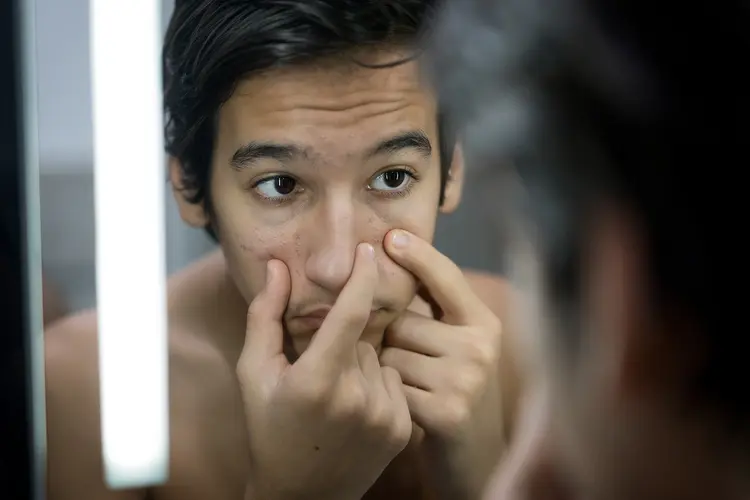If there’s one thing you can count on as a teen, it’s acne. More than 85% of teenagers have this common skin problem, which is marked by clogged pores (whiteheads, blackheads), painful pimples, and, sometimes, hard, deep lumps on the face, neck, shoulders, chest, back, and upper arms.
If your mom and dad had acne, chances are good that you will, too. But there are many ways to prevent (and treat) acne today to keep the condition minimal, prevent scarring, and leave your skin glowing.
Acne affects people of all skin tones, but it can be particularly challenging for people with darker skin. One pimple or breakout in dark skin can result in long-lasting dark marks, scars, or keloids (scar tissue that grows beyond the original scar). Post-inflammatory hyperpigmentation (PIH) can develop from the skin’s release of melanin, which can be triggered by acne or harsh acne products. PIH is more likely to occur in darker skin and can last longer than the acne itself.
Before starting any treatment, it is important to differentiate between acne and other conditions that may look similar, such as ingrown hairs. Treating acne should be done gently to prevent further irritation and dryness, which can worsen dark spots and scarring. Topical retinoids and benzoyl peroxide can help clear pores and reduce inflammation.
Types of Acne in Teens
Acne can appear as one of the following:
Whiteheads: White dots that are pores impacted with oil and skin covered by skin layers.
Blackheads: Black bumps that are impacted pores in which material pushes out through the follicles.
Papules, pustules, or nodules: More serious lesions appearing red and swollen due to inflammation or infection of the tissue around the clogged follicles, which are often painful and feel hard.
Cysts: Deep, pus-filled pimples.
What Causes Acne?
To understand acne, you need to know how your skin works. The pores in your skin contain oil glands. When you hit puberty, there’s an increase in sex hormones called androgens. The excess hormones cause your oil glands to become overactive, enlarge, and produce too much oil, or sebum. When there’s too much sebum, the pores or hair follicles become blocked with skin cells. The increase in oil also results in an overgrowth of bacteria called Cutibacterium acnes.
Acne Symptoms in Teens
While the symptoms of acne vary in severity, you’ll notice these signs on areas of your body with the most oil glands (the face, neck, chest, back, shoulders, and upper arms):
Clogged pores (pimples, blackheads, and whiteheads)
- Papules (raised lesions)
- Pustules (raised lesions with pus)
- Cysts (nodules filled with pus or fluid)
The least severe type of acne lesion is the whitehead or blackhead. This type is also the most easily treated. With more extensive acne, you may need prescription medications to ease inflammation, bacterial infection, redness, and pus.
Acne Treatment in Teens
The first line of defense against acne is a skin care routine. That routine could include:
Cleanse: Wash your face with a gentle cleanser in the morning and evening to remove dirt, oil, and makeup. Look for products that are labeled as non-comedogenic, which are formulated not to clog pores. Benzoyl peroxide and salicylic acid are both helpful ingredients as well; benzoyl peroxide is good for oily skin but could irritate more sensitive skin. If you have more sensitive skin, look for salicylic acid.
Mask: Once or twice a week, use a face mask to provide extra nourishment and hydration to your skin.
If the acne hasn’t improved after 3 months, it’s time to visit a dermatologist. The first thing they’ll likely try is topical prescriptions.
Topical prescriptions
Clindamycin is a topical antibiotic that decreases the bacteria that cause acne.
Benzoyl peroxide manages the bacteria and reduces inflammation.
Adapalene (Differin) or tretinoin (Retin-A), which are retinoids, clear clogged pores.
While benzoyl peroxide and adapalene can be obtained without a prescription, stronger versions of these products can only be obtained through a doctor’s prescription. On the other hand, topical antibiotics and tretinoin are only available with a prescription from a doctor.
Oral antibiotics: Oral antibiotics can kill bacteria and reduce swelling. However, this treatment can carry risks over long periods of time.
Isotretinoin: Isotretinoin is a type of oral retinoid that can shrink oil glands. This medication also comes with health risks, so it is typically only prescribed as a last resort after other treatments have failed.
Testosterone and Teen Acne
Testosterone is a hormone that plays a key role in the development of male secondary sexual characteristics, including increased muscle mass and body hair. When trans and nonbinary teens take testosterone as part of their gender affirmation process, it can also result in an increase in sebum.
Can I Prevent Acne?
Here are some tips that may help control acne.
- Don’t over-wash or use harsh scrubs. Acne is not caused by dirt. Two gentle washings a day is enough. Too much cleaning can leave skin irritated and dry, triggering glands to produce more oil, increasing the likelihood of pimples.
- Use oil-free or noncomedogenic products (those that won’t clog pores) on your face.
- Don’t squeeze or pick blemishes. Popping pimples can drive acne bacteria deeper into the skin. Picking can lead to more inflammation and permanent scarring.
- Don’t let acne define who you are. Do what you can to improve your skin, working with a dermatologist, if necessary, and keep doing the things you enjoy.
When Should I Call My Doctor About Acne?
Whether you have a few pimples or more serious acne, talk to your doctor about treatments. Treating acne early is the key to avoiding permanent scarring.
